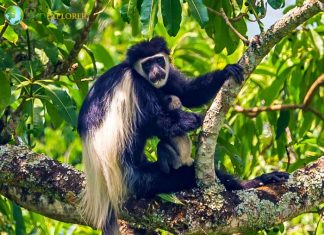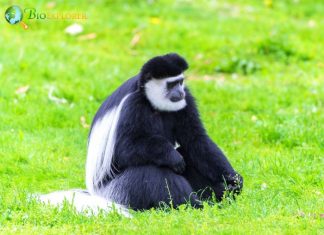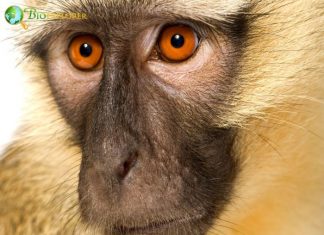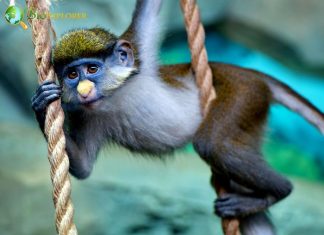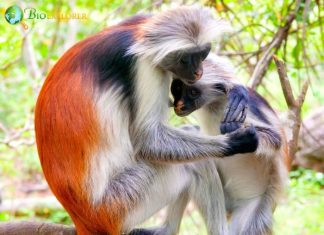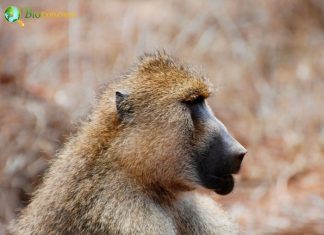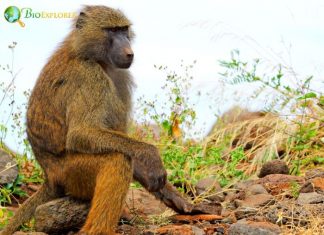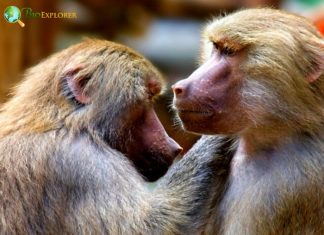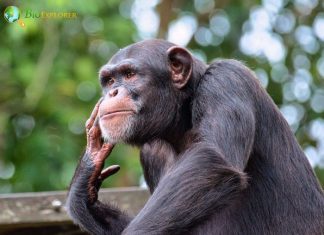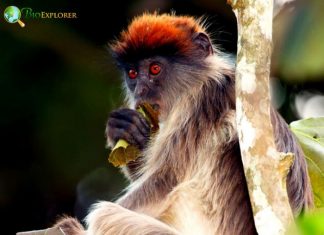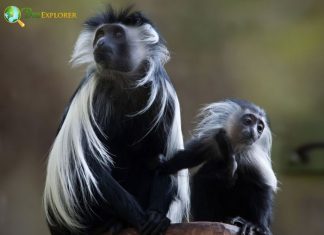Mount Kilimanjaro Guereza
Species Name: Colobus caudatus
The Mount Kilimanjaro guereza (Colobus caudatus) is one of the 7 subspecies of the mantled guereza. It is found in Kenya and Tanzania in the forests surrounding Mount Meru and Mount Kilimanjaro.
Mantled Guereza
Species Name: Colobus guereza
The mantled guereza (Colobus guereza), also known as the guereza, Abyssinian black-and-white colobus, or eastern black-and-white colobus, is a black-and-white colobus, a species of Old World monkey. The mantled guerezas are typically diurnal.
Highland Mangabey
Species Name: Rungwecebus kipunji
The kipunji (Rungwecebus kipunji), also called the highland mangabey, is an Old World monkey inhabiting the upland forests of Tanzania. Kipunji is active during the day and mostly confine their activity to trees and rarely reach the ground.
Sanje Mangabey
Species Name: Cercocebus sanjei
Sanje mangabey, also called the Sanje crested mangabey and Sanje River mangabey, are Old World monkeys endemic to Tanzania, a sovereign state in East Africa. Some Sanje mangabeys prefer their own company to that of others and live alone.
Udzungwa Red Colobus
Species Name: Piliocolobus gordonorum
The Udzungwa red colobus (Piliocolobus gordonorum), also called the Iringa red colobus or the Uzungwa red colobus is endemic to Tanzania.
Vervet Monkey
Species Name: Chlorocebus pygerythrus
The vervet monkey (Chlorocebus pygerythrus) is an Old World monkey of the Cercopithecidae family endemic to southern and eastern Africa. Not only can vervet monkeys skilfully navigate through the treetops, but they can also swim.
Schmidt’s Red-tailed Monkey
Species Name: Cercopithecus ascanius
The Schmidt's red-tailed monkey, also called the red-tailed guenon, Schmidt's guenon, or black-cheeked white-nosed monkey is a primate species in the Cercopithecidae family. The Schmidt's red-tailed monkey is named for its red coloration on the underside of its tail, as well as the bicolor coloration of its tail as the reddish color increases from the base to the tip.
Zanzibar Red Colobus
Species Name: Piliocolobus kirkii
The Zanzibar red colobus (Piliocolobus kirkii) is endemic to Unguja, the main island of the Zanzibar archipelago off the coast of Tanzania. The Zanzibar red colobus, often referred to as Kirk's red colobus is named after Sir John Kirk, the British resident of Zanzibar who first spotted these creatures.
Yellow Baboon
Species Name: Papio cynocephalus
The yellow baboon (Papio cynocephalus) is another baboon species in the group of Old World monkeys. They resemble the Chacma baboon but are slightly smaller and have a less elongated snout. Yellow baboons also have white fur on internal surfaces, such as their cheeks and limbs, similar to the color of the human forearm.
Olive Baboon
Species Name: Papio anubis
The Olive baboon (Papio anubis), also called the Anubis baboon, is a species of the Cercopithecidae family of Old-World monkeys. The name comes from the Egyptian god Anubis.
Kinda Baboon
Species Name: Papio kindae
The Kinda baboon (Papio kindae) is a species of baboon found in the Miombo forests of Angola, Zambia, the Democratic Republic of the Congo, and possibly western Tanzania. The species is named after the town in the southern Democratic Republic of the Congo.
Common Chimpanzee
Species Name: Pan troglodytes
The chimpanzee, also known simply as the chimp, is a species of great ape native to the forests and savannas of tropical Africa. Chimpanzees and humans are thought to have a common ancestor that lived about eight million years ago.
Ashy Red Colobus
Species Name: Piliocolobus tephrosceles
The Ashy-red Colobus or Ugandan red Colobus is an endangered species of red Colobus endemic to Eastern Africa. Like other colobus monkeys, Ashy Red has small thumbs that allow it to comfortably grip branches and swing nimbly through the canopy. In 2001, the ashy-red Colobus was recognized as a separate species.
Angolan Colobus
Species Name: Colobus angolensis
The Angolan Colobus is a conspicuously-patterned monkey with a very long tail that helps it maintain its balance as it moves quickly through the trees. Although the species is named after Angola, it's rare in this country.


